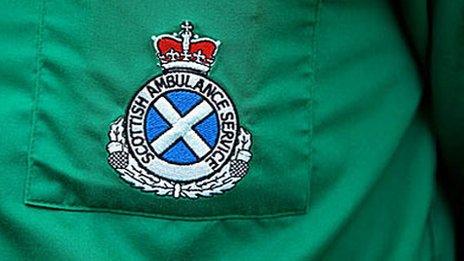'Common sense' plea over ambulance speeding fines
- Published

Trusts have to appeal against the £100 fine by proving the ambulance was used for a blue light call
Ambulance trusts spent hundreds of hours having to appeal against speeding fines issued to emergency vehicles by police forces.
More than 20,000 tickets were issued to paramedics after they were caught on speed cameras responding to 999 calls.
Only 400 of those tickets were upheld, a Freedom of Information request by the BBC has found.
The police said some speed cameras only captured the speed and number plate of the vehicle.
Health bosses have called for the automatic exemption on emergency vehicles to be better enforced. Some trust staff are spending 40 hours a month appealing against the fines.

A South Western Ambulance Service paramedic said saving a life was the main priority
A Freedom of Information request by the BBC to all ambulance trusts in England showed they received 23,227 speeding tickets between 2009 and 2014.
If not appealed against, some trusts would be facing a bill of up to £160,000 a year.
Yorkshire Ambulance Service Trust had to appeal against fines that would amount to more than £774,000 over five years, while the South Central Ambulance Service Trust, covering Berkshire, Buckinghamshire, Hampshire and Oxfordshire, spent up to 10 hours a week appealing against the fines.
The highest speed recorded was 115mph in a 50mph zone by the South Western Ambulance Service.

Appeal process:
The ambulance trust administrator checks the vehicle registration against vehicle records to get the radio call sign for the vehicle
The call sign will then be checked against the 999 incident logging information for the date and time of the ticket to check whether the vehicle was on a blue light emergency call. With the vast majority of tickets this is the case
The administrator will then confirm this to the police in a formal letter
If this is not the case the details are passed to the local operational manager to locate and notify the driver and their details are passed to the police
The minimum penalty, external for speeding is a £100 fine and three penalty points added to the driver's licence

'Common sense'
Carl Rees, from the Association of Ambulance Chief Executives, said "common sense should be applied" and "notices should only be sent out if no blue lights can be seen flashing".
"After the appropriate checks have been made the PCN (penalty charge notice) should be waived. We understand that this is what happens in the majority of cases," he said.

The law:
Section 87 of the Road Traffic Regulation Act 1984 states:
"No statutory provision imposing a speed limit on motor vehicles shall apply to any vehicle on an occasion when it is being used for fire and rescue authority purposes."
"If blue lights are displayed, then police will assume, in the absence of any evidence to the contrary, that the exemption is valid and no further action will be taken. No paperwork will be sent to the organisation concerned."
Source: "Guidance regarding the legal obligations placed on forces as body corporate when dealing with speeding and red light offences by emergency service vehicles"
Association of Chief Police Officers of England, Wales and Northern Ireland

Assistant Chief Constable Stephen Barry, from the National Police Chiefs' Council, said while police would generally stop notices from being sent out, this was more difficult since the introduction of average speed checks.
"When an emergency vehicle clearly displaying blue lights triggers a camera, but the police can see that it was being driven safely in accordance with the law with blue lights displayed, they would generally stop notices from being sent out.
"This has been made more difficult with the introduction of average speed checks in recent years, which usually capture the speed and number plate of the vehicle but not necessarily an image."
- Published28 December 2013
